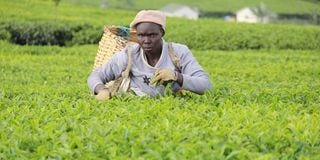Making guaranteed minimum return work

A worker at Nandi Tea Estate Limited in Nandi Hills plucks tea leaves on April 4, 2014. Agriculture remains the most important economic activity in Kenya. Our most lucrative exports remain tea, horticulture and coffee. In Central Kenya, politics is hinged on agriculture.
Agriculture remains the most important economic activity in Kenya. Our most lucrative exports remain tea, horticulture and coffee. In Central Kenya, politics is hinged on agriculture.
More than two-thirds of Kenyans are employed in the sector. UDA party promised a guaranteed minimum return for certain agricultural products. How to fulfil this promise calls for debate.
In politics, leaders must always keep the promises they make to the citizenry, or else they face a backlash. Even Jesus alluded to this when he said in Mathew 7:19 that “every tree that does not bear fruit is cut down and thrown into the fire. Therefore, by their fruits, we shall know them." Three key questions arise.
First, what is the guaranteed minimum return and what are its goals? Basically, this is a price paid by the government to a farmer for an agricultural product irrespective of market conditions. The goals include boosting farm production and incomes, farm commodity surplus removal and shoring up exports.
In 1929, the US established the Agricultural Marketing Act, which introduced a price support mechanism.
The UK went further with the Agriculture Act of 1947. India established its Agriculture Price Commission in 1965 to recommend prices for agricultural products.
Governments worldwide render support to farmers either through a subsidy programme that consists of measures such as the purchase of farm inputs or a guaranteed minimum return.
A guaranteed minimum return scheme is superior to a subsidy plan in that subsidies are procurement-heavy. The government must, for example, buy fertilisers for onward transmission to the farmers. If that happens, 30 per cent of the purchase price will be the profit margin of the seller, while 20 per cent will be lost in transportation charges. Another 20 per cent will be lost in corruption and bureaucratic inefficiency. Thus the farmer gets a net value worth 30 per cent. If the scheme was worth Sh100 million, the farmers will get actual fertilisers worth Sh30 million.
Guaranteed minimum return on the other hand is support sent directly to the farmer, hence circumventing these bureaucratic hindrances.
Subsidies like fertilisers, unless where they include an element of cost-sharing, tend to operate on the “equality is equity” principle. Often, subsidised fertilisers are distributed equally to all farmers, yet some have big and others have small farms. The topography and soil quality also differs.
Guaranteed minimum return, on the other hand, often hinges on each farmer’s productivity level. The resources are thus shared rationally and more productively.
Other conditionalities can be attached to a guaranteed minimum return scheme, including proper record keeping, vaccination of animals and incentivising farmers to aggregate for better negotiation in the market.
Distort the market
Such goals are not realisable under a subsidy programme. Subsidies can also distort the market and mask farmers’ inefficiencies. For an agricultural product whose actual cost of production is Sh100,a government subsidy of Sh40 will make the product artificially cheap at Sh60 in the marketplace. The farmers can also refuse to pass this benefit of Sh40 to the buyer and hence benefit twice. They could do this by artificially pricing their commodity above Sh100 ( excluding profit ).
On the other hand, a guaranteed minimum return scheme can work parallel to market pricing. Assuming a farmer's cost of production is Sh100 and he prices his commodity at Sh120. A guaranteed minimum return can be paid after the closure of a market, say Sh10 for each commodity sold, regardless of the sale amount. This does not occasion any market distortion. That explains the effort by the World Trade Organisation to remove subsidies in agriculture.
Guaranteed minimum return also leaves a better audit trail. Information technology, which includes triangulating information with reputable institutions like banks and cooperatives, can be used to identify authentic farmers and relay monetary support.
Since agricultural subsidies involve dishing out actual goodies,the audit trail is usually very thin and depends on the magnanimity of record keepers. It cannot be easily authenticated through independent third parties.
The second question is, which level of government should implement a guaranteed minimum return?
Agriculture is devolved under the Fourth Schedule of the Constitution. Counties should, therefore, help the UDA government to actualise this vision. However, the national government is best placed to prepare a policy document on the programme.
Thirdly, within a county set-up, how can this programme be crafted?
Counties desiring to set up the programme should first identify the agricultural sub-sector they wish to support. The target should be a sub-sector where the devolved unit has a competitive edge and is likely to impact the widest section of the community and ensure regional balance.
The product targeted must have the potential to create the best value linkages that start at farming and terminate at manufacturing, if possible. Sectors that already exist are the best bet.
Murang’a County, for instance, has three ecological zones. There is the lower region, which is dry, as well as the middle and upper zones. Support for mangoes covered lower regions and milk covered middle and upper regions. Mangoes and milk are produced and value-added within and without the county. The two value chains were already pre-existing in Murang’a albeit with problems.
The next step is integrating the programme into county planning tools and setting aside funds in the budget.
The third step includes passing the policy and legislative framework that will underpin the programme. The regulations set out the criteria for choosing beneficiaries of the scheme. Fair and open criteria need to be embedded in the regulations. Without the congruence of regulations, policy, planning tools and budget provision, the Controller of Budget would veto such an initiative.
Dr Kang’ata is the Governor of Murang’a County.





